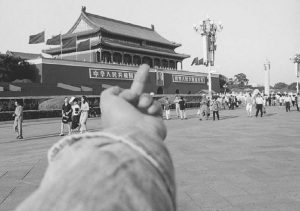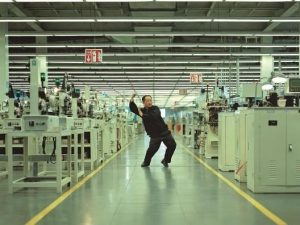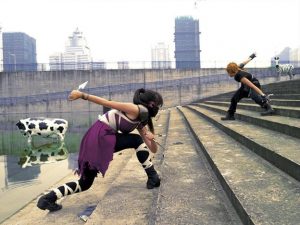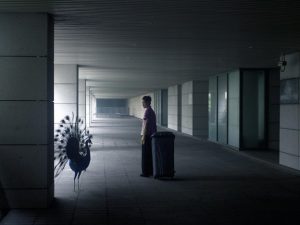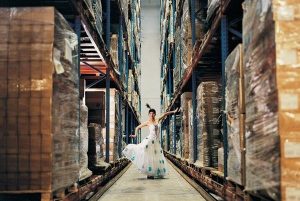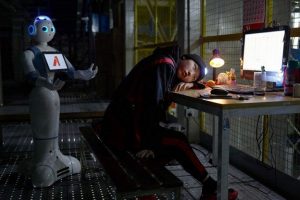Essay: Abnormal / Normal: the art of Cao Fei
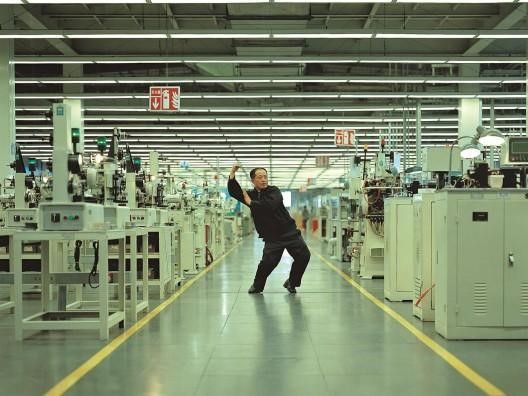
There are two dead babies sitting in a medical pan inside a nondescript room. These babies face one another. Are they conjoined twins? There are tubes connected to the twin cadavers. A Chinese couple, a man and a woman, sit in chairs on either side of the babies. The tubes from the babies are connected to the arms of the couple. They are feeding their own blood into the mouths of the dead babies, who receive the elixir without discernible effect as the blood dribbles down their faces. It is a horrendous scene, made all the more horrendous by the fact that it is so compelling to look at, so fascinating to think about. Are these people trying to help the babies, connect with them somehow? Are they making fun of these dead babies or of the situation? Are we meant to laugh, cry, recoil in horror? What is this disturbing scene and why are we being subjected to it?
Sun Yuan and Peng Fu, Linked Bodies (2000)
Well, we are in Shanghai in the year 2000. The millennium is upon us. We’re at an art exhibit. The couple feeding blood to the dead babies are Sun Yuan and Peng Yu. The show has been curated and organized by two Chinese artists who will go on to become international art stars. They are Feng Boyi and Ai Weiwei. They have created a show called “Fuck Off.” It is neither, like most exhibits of Chinese art at the time, sponsored by the Chinese government nor by any Western government or institution. The show was an epochal moment in Chinese contemporary art and will, I’d wager, become recognized more and more over time as one of the crucial moments in the history of art in general, like the famous and era-shifting Armory Show in New York City 1913.
Ai Weiwei, Fuck Off (2000)
I bring up “Fuck Off” because this was the aesthetic milieu in Chinese contemporary art at the time Cao Fei was reaching adulthood and becoming an artist in her own right. The mood among many Chinese artists at the turn of the millennium was one of independence. This independence cut both ways. On one hand, these artists were striking out against the standard socialist realism being advocated by Chinese authorities. Ai Weiwei has, spectacularly, challenged Chinese authorities so directly that he’s been arrested several times since the “Fuck Off” show and has spent time in prison for his efforts. But that’s only one side of the story of independence that the artists of the “Fuck Off” era were trying to assert. There was also the desire to create art from a Chinese sensibility without catering to Western ideas, aesthetics, tastes, political assumptions, or anything else.
Since the year 2000, Cao Fei has become recognized globally as among the more important Chinese contemporary artists. She had a solo show at MoMA PS1 in 2016 and has appeared in dozens of biennials and group shows around the world over the last fifteen years. A major show at the Serpentine Gallery in London this year was disrupted by the COVID-19 pandemic but still managed to generate quite a large critical response. But her work is consistently misunderstood in the West partly because it has been assumed that since she questions the official aesthetics of the Chinese state that means she’s adopted a Western aesthetic sensibility. This is by no means the case, as a closer look at her art makes clear.
Cao Fei is often described as being a multimedia artist. What this really means is that she doesn’t have a medium per se, which is true of many, if not most, contemporary artists at this point in the early 21st century. Cao Fei does digital work, photography, film, performances, installations, posts on social media. Still, it could be said that she uses film more than any other medium, which has been true since Imbalance 257, a film she made while still an art student in 1999, and which was the first work to bring her attention in the wider artworld.
That film, like much of her work until the mid to later oughts when she moved to Beijing, centered on the experience of her hometown, Guangzhou. Cao Fei was born in Guangzhou in 1978. This is a more significant fact than it might seem to someone unfamiliar with the recent history of China. Indeed, the history of Guangzhou is so complex, and so wrapped up with the transformations of China going back to ancient times, that one could spend the rest of one’s life trying to understand the place. We don’t have that kind of time and I certainly do not have that expertise. Suffice it to say, Guangzhou has long been an important and populous Chinese city and frequently a place, going back to the ancient days of the Silk Road, through which China interfaced with the rest of the world. This fact came to play crucially in the 1980s. Deng Xiaoping, the paramount leader of China from roughly the late 1970s to the late 1980s, first began to experiment with opening up the Chinese economy in Guangzhou. Guangzhou became the laboratory and poster-child, if you will, of China’s ‘new economy’, that blend of capitalism and state control that so characterizes China today, and that plays such a massive role in the global economy of the early 21st century.
So, Cao Fei came to be Cao Fei in the bewildering landscape of a massive city of manufacturing and trade that was completely reinventing itself and, in the process, reinventing economics and politics in general. Cao Fei’s art emerges from the experience of being a human being caught in the pinchers of overwhelming historical change. Of course, that’s fine to articulate in the abstract. But how does this social and economic situation express itself in actual works of art? How does Cao Fei generate a specific aesthetic from the reality of being a Guangzhouer in an age of great transformation?
Cao Fei, Whose Utopia (2006)
A relatively early and much-celebrated work by Cao Fei, Whose Utopia (2006), is probably the best place to start in answering these questions. Whose Utopia is a roughly twenty-minute film shot inside the Osram lighting factory in the Pearl River Delta region outside of Hong Kong. Judging by the first few minutes, the film would seem largely to be about glass tubes. These tubes are handled by various industrial robots, clamped and shaped and filled with liquids and shot down all sorts of ramps, conveyor belts, and then, finally, handled by human beings in the later stages of the production process. An eerie soundtrack composed of a mix of industrial noises and, perhaps, the sounds of birds accompanies these scenes. That is Chapter One. Chapter Two brings a quite radical shift in scene and tone. We see the now-familiar insides of the lighting factory but several of the workers now dance about the space in ballerina outfits, or do Tai Chi, or play electric guitar. Behind them, work goes on as normal. The final chapter of the film shifts again. A mournful little tune, Empty Room Waltz by Prague, plays as various workers from the factory are filmed individually for a few seconds each. It’s something that Andy Warhol might have done, though in Cao Fei’s case the filmed portraits are of much shorter duration. We get what amounts to a snapshot of the various human beings peopling this massive industrial space. It is oddly, unexpectedly moving.
Around the same time that Cao Fei made Whose Utopia she also made a short film and accompanying series of photographs called Cosplayers (2004). A cosplayer, for anyone paying zero attention to global popular culture over the last few decades, is someone who dresses up in the costume of a character from video games, movies, or a comic book series, often originating in Japanese manga and anime but branching, in more recent years, to Western comic book figures and superheroes as well.
Cao Fei, Cosplayers (2004)
Cao Fei’s film and photography series features a number of cosplayers engaging in fantasy roleplay amidst the otherwise mundane and in some cases bleak environment of large housing developments, commercial and retail spaces, and semi-industrial non-places where can be found piles of concrete rubble, trash heaps, and the flotsam and jetsam of construction and destruction common to all big cities. In some scenes from the film and photographs, the characters seem to be completely immersed in their own world of fantasy and roleplay. The surrounding environment is simply the backdrop against which some fantastic story is being played out. In other shots, the characters seem to have fallen back again into the mundanity of the environment. Whatever spell they were under has been broken. The characters are now just Chinese young people again, wearing absurd costumes and engaging in failed acts of escapism that only further highlight the sense of alienation that must have motivated the turn to cosplay in the first place.
In the Western reception of Cao Fei, works like Whose Utopia and Cosplayers have been interpreted along the lines of a critique of the alienating effects of Modernity or as an outcry against both global capitalism on the one hand and the authoritarian state capitalism of China on the other. An Artnet review of Cao Fei’s MoMA PS1 show in 2016 was, for instance, titled “Cao Fei Tackles the Numbing State of Modernity in Her Solo Show at MoMA PS1.” Cao Fei has, in interviews and statements about her art, sometimes reinforced this interpretation of what she’s been doing.
Cao Fei, Haze and Fog (2013)
Indeed, this particular reception of her work may even have pushed her to create art that satisfies this interpretive scheme. In 2013, for instance, Fei made a short film entitled Haze and Fog. The film is a riff on the zombie theme. In this case, the zombies are the everyday residents of an anonymous city in contemporary China who are mostly just trying to get by. A brief explanation of the film on the University of Salford website (the University commissioned the film) explains that:
Having migrated to the modern metropolis, the zombies fulfill their roles as cleaners, couriers, security guards and baby sitters, moving through their urban environments without fulfilment or meaningful direction. At first Haze and Fog seems to take a critical stance towards China’s rapid urbanisation as a catalyst for social disintegration. However, Fei’s work moves beyond the specificities of the local, to ask more complex questions about how societies operate according to class-based hierarchies, and what we can do to break free from oppressive systems.
And here is the dilemma in a nutshell. Good art is inherently ambiguous. It has no clear meaning, intent, purpose, function. I’m not going to prove this statement or argue for it. I take it as axiomatic. Others will disagree. Fine. But if the axiom that art is inherently ambiguous is true, then the above explanation of Cao Fei’s art is going to come off as overly reductive, which I think it does. Because I am not at all sure that Haze and Fog “asks more complex questions about how societies operate according to class-based hierarchies” and I am quite sure that it has nothing at all to say about “what we can do to break free from oppressive systems.” I suppose you could argue that the film carries the implied message “it is weird to be zombie,” a sentiment we can all surely accept, though even this sentiment is undercut by the fact that the zombies in Fei’s film have, in a sense, learned to live normal lives.
In fact, all of Cao Fei’s artwork becomes simplistic and one-dimensional when viewed as a commentary on contemporary socio-economic realities. It becomes downright tiresome and soporific when the further burden is placed upon the work that it should not only diagnose social ills but also provide some advice on how we might “break free from oppressive systems.”
Let’s look again at Whose Utopia. The reason that the third and final chapter of Whose Utopia is strangely moving is that we cannot draw any specific conclusion from the faces and gestures, the sheer physical presence of those workers at a lighting factory in the Pearl River Delta. In the first chapter of the film, we’ve been shown something of the reality of the plant itself, the machines and how they work, the look and feel and functioning of the factory as a factory. In the second chapter, we glimpse the inner lives and fantasies of the human beings who spend many hours in that place, day after day in its rhythmic fashion.
We could be forgiven, after watching these chapters, for thinking that we are being presented here with a straightforward dichotomy. There is the soulless and alienating reality of the factory itself-Chapter One. And then there is the rich inner world of the human beings working in the factory on the other-Chapter Two. The first is bad, the second is good. The first is inauthentic and mechanistic. The second is rich, beautiful, meaningful, human.
Cao Fei, Whose Utopia (2006)
But this simple dichotomy doesn’t hold up in the third chapter of the film. In fact, the workers seem neither especially alienated nor particularly self-realized in Chapter Three. This is neither a utopia nor a dystopia. The human beings we get to know for a few seconds as we see them standing next to machines they work on, or in the areas of the factory in which they do various tasks, are simply human beings. We both know and don’t know what is going on in the daily lives of these people. We know, because in looking at each person for a few seconds there is that tiny shock of connection and recognition. At the same time, it is impossible to establish exactly what each person is thinking, feeling, dreaming. And there is the awkward negotiation of looking at someone who is being filmed on camera and isn’t sure exactly what they are supposed to do, how they are supposed to act. The experience of watching the third chapter of Whose Utopia cannot be summed up in a political or sociological statement. In fact, it is resistant to that way of thinking altogether.
In 2016, Izabella Scott interviewed Cao Fei for The White Review. Toward the end of the interview, the film Whose Utopia was brought up. Scott asked Fei, “What did you think of the workers’ conditions?” Fei answered,
It was a clean factory. They had good salaries. I just thought, it’s normal, it’s just how it is. I grew up in Guangzhou in the south of China, which is referred to as ‘the world’s factory’. I watched it change completely. But change is so normal in China. We’ve got used to it. There is always building work and so it’s always noisy. That’s why so many of my films have these loud soundtracks. It’s the noise of cities endlessly being built.
The interpreter, the interviewer, the critic-all are constantly trying to extract from Cao Fei a specific commentary, a judgement about the forms of human experience that Cao Fei documents. But what is interesting to Cao Fei, and this is a matter of aesthetics, is the abnormal-normalcy of what she is capturing on film, or in photographs, or in creating various virtual worlds. She is aesthetically fascinated with the creation of a new normal. She is interested in this new normal as a matter of fact, not as a diagnosis or proclamation. This is not to say that diagnosing and judging and proclaiming can’t or shouldn’t happen. They can. But that’s not what art does, and that’s not the work of interpreting art.
In the rush to smother her art with the apparatus of critical discourse on socio-politics and economics there is the danger of never actually taking the time to look, feel, absorb, and experience the very worlds Cao Fei is trying to show us.
Cao Fei, Asia One (2018)
In a more recent work, Asia One (2018), Cao Fei created an installation and film of the same name for The Guggenheim Museum’s group show One Hand Clapping. The film follows the daily operations at a huge sorting warehouse in Jiangsu Province. It’s a JD.com warehouse and was, at the time of filming, the world’s first fully automated sorting center. JD.com is China’s largest online retailer. Think of it as Amazon times a bunch. One of the amazing things about the film, and this has been true of Cao Fei’s work since at least Whose Utopia, is that we’re given a chance just to look inside these factories and industrial spaces and retail facilities and get a feel for them. In the case of Asia One, there is an uncanny beauty to the largely people-free spaces. Robots and other machines glide around the smooth floors. Very few human beings are needed to oversee the functioning of the warehouse. Those who are needed wander about the space with a dreamlike detachment. It is terrifying and mesmerizing and boring and overwhelming.
The film goes in a number of directions, zooming into the distant future where a group of visitors examine the no-longer-functioning warehouse, which has become a ruin. Other scenes are reminiscent of Whose Utopia as workers dance around in the facility mimicking the pageants that were especially popular during China’s Cultural Revolution and The Great Leap Forward. Finally, there is an ongoing story in which two workers in the facility engage in an awkward, constantly thwarted love affair that also includes an extremely adorable robot.
The primary effect of the film is visceral and emotional. The facility makes perfect sense. JD.com is a direct result of all the economic and social forces that have led us exactly here, a result of the historical forces unleashed in China over the last fifty years. And yet, at the same time, it is completely surprising. Who could have predicted that it would look and feel exactly like this? The film, like all of Cao Fei’s work, explores both the sense of normalcy and the sense of shock that come together with experiencing the reality of a place like the JD.com sorting facility in Jiangsu province.
The trick in truly appreciating the work of Cao Fei is to remain in a state of suspended judgment for as long as possible. This can be difficult to do, since we all feel the need to draw conclusions. There is a desire to decode the work, to decide whether Cao Fei is endorsing or condemning the new normal that she presents to us in her artworks. A New York Times article about Cao Fei’s Asia One was titled “An Artist Warns of a Robot-Ruled Future, Or Is It Our Present. Let’s Discuss.” It is perfectly natural to discuss such things. But resist the impulse for as long as you can. Asia One is, after all, not that interesting as a warning. There are better warnings, more interesting discussions about the dangers and threats of AI or robotic automation. In the space of aesthetics there is the freedom simply to look and feel and to experience. This needs no further justification and neither, therefore, do the artworks of Cao Fei.


